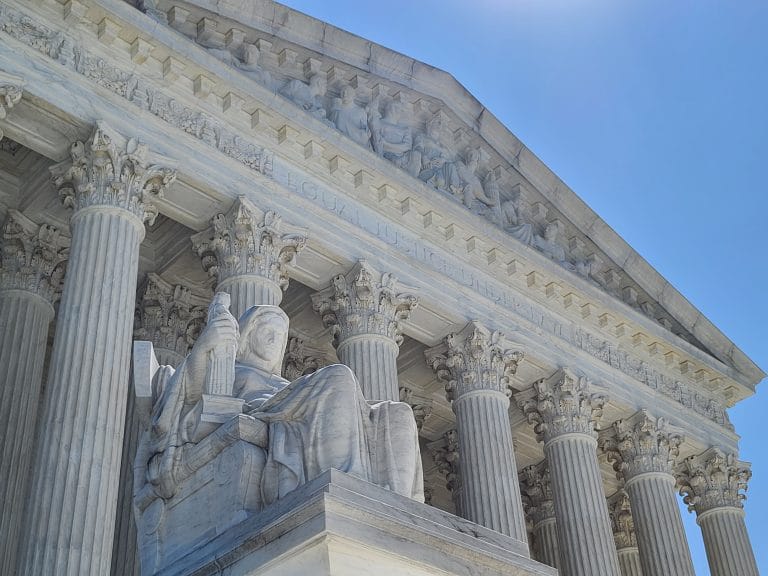The Department of Justice has just launched a Hail Mary request for the Supreme Court to step in and reinstate the Biden administration’s “ghost gun” ban. It’s not yet clear how the Justices will respond.
On Thursday, the Biden administration asked the Supreme Court to stay a Texas federal judge’s nationwide order vacating the ATF’s rule on unfinished frames and receivers in VanDerStok v. Garland. That order was narrowed slightly but left in place this week by the Fifth Circuit Court of Appeals while it prepares to hear the case on its merits.
“The district court’s universal vacatur is irreparably harming the public and the government by reopening the floodgates to the tide of untraceable ghost guns flowing into our Nation’s communities,” Solicitor General Elizabeth Prelogar (D.) wrote in her SCOTUS stay application. “This Court should stay the district court’s vacatur in full. A stay would prevent further irreparable harm to the public while allowing the litigation in this case and other challenges to the Rule to proceed in the ordinary course.”
The emergency stay application was enough to get the Justices’ attention, prompting Justice Samuel Alito on Friday to issue a temporary administrative stay on the district court’s ruling for one week. He also requested the parties to the case to submit briefs before the temporary stay expires. With such immediate action, it’s worth examining the possible outcomes for a significant portion of the President’s gun-control agenda.
The justice overseeing emergency appeals out of the Fifth Circuit is Samuel Alito, whose jurisprudence has favored gun-rights plaintiffs in each Second Amendment case to come before the Court during his tenure. He also happens to be one of the more prominent skeptics of administrative power on the current Court, which is what the legal fate of the ATF’s rule hinges on. One might think then that the outcome of the DOJ’s emergency appeal will be as simple as Justice Alito single-handedly swatting down the Biden administration’s request to allow its executive order to be enforced. But there’s reason to think it won’t be so simple or satisfying for gun rights advocates.
Though a Justice overseeing a given Circuit may individually grant or deny an application for relief, recent experience with emergency motions in gun cases has shown the Court appears to rely on input from all of the Justices when deciding. Justice Sotomayor referred both emergency requests for intervention in the lawsuits against New York’s concealed carry law to the full Court, for instance, as did Justice Barrett with the request to intervene in the battle over Illinois’ ban on so-called assault weapons. In both cases, the full Court declined to intervene, preferring instead to allow the Second and Seventh Circuit Courts of Appeals to proceed with the lawsuits in due course.
Justice Alito even opined on the first request for the Supreme Court to intervene on New York’s law before the Second Circuit makes a decision, emphasizing the deference the Court gives to lower courts’ jurisdictions and procedures.
“I understand the Court’s denial today to reflect respect for the Second Circuit’s procedures in managing its own docket, rather than expressing any view on the merits of the case,” Alito wrote in Antonyuk v. Nigrelli.
Alito and the rest of the Justices may exercise the same degree of restraint in deciding what to do with this latest emergency application.
On the other hand, the party that filed the appeal in this case is unlike those in the previous cases. Rather than gun rights plaintiffs seeking relief, the U.S. Government is asking the Supreme Court to step in this time. The Court often gives DOJ and other federal entities more deference when they request intervention.
The first Second Amendment cert grant to happen post-Bruen—on domestic violence restraining orders and gun prohibition, in United States v. Rahimi—resulted from a DOJ cert petition. Plus, the issuance of a temporary stay is already more deference than was shown to the gun-rights plaintiffs in either the New York or Illinois emergency applications. That factor could tip the balance toward the Justices preferring to give the Biden administration more leeway in exercising its authority while the case plays out in the Fifth Circuit.
At the same time, however, there is a crucial difference between the ghost gun rule and Rahimi that might be dispositive. Unlike the ATF frame and receiver rule, the law struck down by the Fifth Circuit in Rahimi was the result of an Act of Congress passed several decades ago. A ruling striking down an established law creates more potential chaos and uncertainty for the criminal justice system. Rahimi also allows the Court to refine its newly crafted Bruen test for Second Amendment cases.
The VanDerStock case, on the other hand, merely vacated an administrative regulation that had only been on the books for less than a full year. In other words, as the Fifth Circuit put it when it declined to issue a stay on the order vacating the rule, refusing to intervene at this early stage “effectively maintains, pending appeal, the status quo that existed for 54 years from 1968 to 2022.”
Finally, there’s one last possible way the emergency application could go, which the Solicitor General hinted at in her brief: a full-on cert grant to hear the case as part of the Court’s 2023 term.
“Given the gravity and urgency of the public safety issues at stake, if the Court is not prepared to grant a stay, it may wish to construe this application as a petition for a writ of certiorari before judgment, grant the petition, and set this case for argument this fall,” Prelogar wrote.
This is perhaps the least likely outcome considering it would involve circumventing the federal appeals courts before they have had a chance to arrive at a judgment. While not unheard of, it would be an extraordinary step for such a recently-enacted rule governing a relatively niche segment of American gun policy.
Whichever way the Supreme Court decides to go in handling DOJ’s emergency application, it will be significant in marking the first time the Court has formally weighed in on one of President Biden’s signature gun-control regulations.






